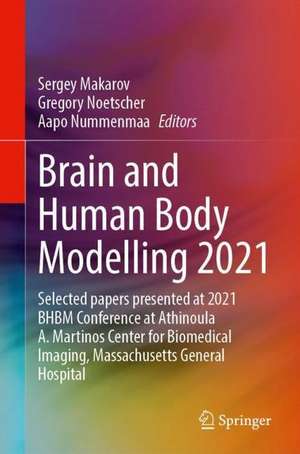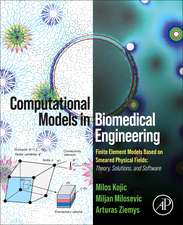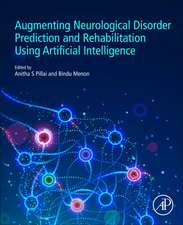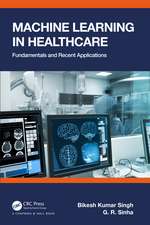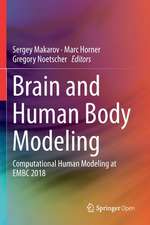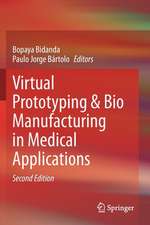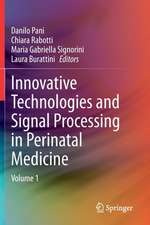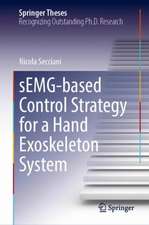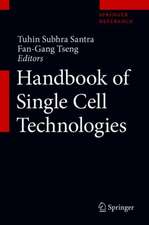Brain and Human Body Modelling 2021: Selected papers presented at 2021 BHBM Conference at Athinoula A. Martinos Center for Biomedical Imaging, Massachusetts General Hospital
Editat de Sergey Makarov, Gregory Noetscher, Aapo Nummenmaaen Limba Engleză Paperback – 30 noi 2022
This is an Open Access book.
| Toate formatele și edițiile | Preț | Express |
|---|---|---|
| Paperback (1) | 330.81 lei 6-8 săpt. | |
| Springer International Publishing – 30 noi 2022 | 330.81 lei 6-8 săpt. | |
| Hardback (1) | 400.84 lei 6-8 săpt. | |
| Springer International Publishing – 30 noi 2022 | 400.84 lei 6-8 săpt. |
Preț: 330.81 lei
Preț vechi: 348.22 lei
-5% Nou
Puncte Express: 496
Preț estimativ în valută:
63.30€ • 66.39$ • 52.70£
63.30€ • 66.39$ • 52.70£
Carte tipărită la comandă
Livrare economică 01-15 aprilie
Preluare comenzi: 021 569.72.76
Specificații
ISBN-13: 9783031154539
ISBN-10: 3031154533
Pagini: 172
Ilustrații: VI, 172 p. 81 illus., 80 illus. in color.
Dimensiuni: 155 x 235 mm
Greutate: 0.26 kg
Ediția:1st ed. 2023
Editura: Springer International Publishing
Colecția Springer
Locul publicării:Cham, Switzerland
ISBN-10: 3031154533
Pagini: 172
Ilustrații: VI, 172 p. 81 illus., 80 illus. in color.
Dimensiuni: 155 x 235 mm
Greutate: 0.26 kg
Ediția:1st ed. 2023
Editura: Springer International Publishing
Colecția Springer
Locul publicării:Cham, Switzerland
Cuprins
Part 1 Low Frequency Electromagnetic Modeling and Experiment. Tumor Treating Fields.- 1. Nichal Gentilal, Ariel Naveh, Tal Marciano, Zeev Bomzon, Yevgeniy Telepinsky, Yoram Wasserman, and Pedro Cavaleiro Miranda. The impact of scalp’s temperature in the predicted LMiPD in the tumor during TTFields treatment for glioblastoma multiforme.- 2. N. Mikic, F. Cao, F.L. Hansen, A.M. Jakobsen, A. Thielscher, and A.R. Korshøj. Standardizing skullremodeling surgery and electrode array layout to improve Tumor Treating Fields using computational head modeling and finite element methods.- Part 2 Low Frequency Electromagnetic Modeling and Experiment. Neural Stimulation in Gradient Coils.- 3. Yihe Hua, Desmond T.B. Yeo, and Thomas KF Foo. Peripheral Nerve Stimulation (PNS) Analysis of MRI Head Gradient Coils with Human Body Models.- Part 3 Low Frequency ElectromagneticModeling and Experiment. Transcranial Magnetic Stimulation.- 4. Mohammad Daneshzand, Lucia I. Navarro de Lara, Qinglei Meng, Sergey N. Makarov, Tommi Raij, and Aapo Nummenmaa. Experimental verification of a computational real-time neuronavigation system for multichannel Transcranial Magnetic Stimulation.- 5. Tayeb Zaidi and Kyoko Fujimoto. Evaluation and Comparison of Simulated Electric Field Differences Using Three Image Segmentation Methods for TMS.- 6. Qinglei Meng, Hedyeh Bagherzadeh, Elliot Hong, Yihong Yang, Hanbing Lu, Fow-Sen Choa. Angle-tuned Coil: A Focality-Adjustable Transcranial Magnetic Stimulator.- Part 4 Low Frequency Electromagnetic Modeling and Experiment. Spinal Cord Stimulation.- 7. Sofia R. Fernandes, Mariana Pereira, Sherif M. Elbasiouny, Yasin Y. Dhaher, Mamede de Carvalho, and Pedro C. Miranda. Interplay between Electrical Conductivity of Tissues and Position of Electrodes in Transcutaneous Spinal Direct Current Stimulation (tsDCS).- Part 5 High Frequency Electromagnetic Modeling and Experiment. MRI Safety with Active and Passive Implants.- 8. James E. Brown, Paul J. Stadnik, Jeffrey A. Von Arx, and Dirk Muessig. RF-induced Heating Near Active Implanted Medical Devices in MRI: Impact of Tissue Simulating Medium.- 9. Gregory M Noetscher, Peter Serano, Ara Nazarian, Sergey N Makarov. Computational Tool Comprising Visible Human Project® Based Anatomical Female CAD Model and Ansys HFSS/Mechanical® FEM Software for Temperature Rise Prediction near an Orthopedic Femoral Nail Implant during a 1.5 T MRI Scan.- Part 6 High Frequency Electromagnetic Modeling. Microwave Imaging.- 10. Peter Serano, Johnathan Adams, Ara Nazarian. Modeling and Experimental Results for Microwave Imaging of a Hip with Emphasis on the Femoral Neck.
Notă biografică
Sergey Makarov/Makaroff is a professor of Electrical and Computer Engineering at Worcester Polytechnic Institute, having taught a wide variety of graduate and undergraduate classes and established an active record of academic and research advising. His formal educational background is in applied mathematics and electromagnetics but since moving to WPI in 1998, his research field has been shifted to bioelectromagnetics. Dr. Makarov has published about 150 conference and journal papers, three books, and he holds 8 patents with two other pending. He has received numerous departmental and institute-wide awards for his teaching, advising, and service. Dr. Makarov is also a member of the Research Staff at the Athinoula A. Martinos Center for Biomedical Imaging at Massachusetts General Hospital, conducting investigative studies in non-invasive brain stimulation and neuroimaging technologies.
Gregory Noetscher is a senior research electrical engineer with the US Army at the Combat Capabilities Development Command Soldier Center in Natick, MA, having worked on and coordinated a variety of experimental and simulation projects related to precision guided cargo airdrop beginning in 2003. His research interests since 2009 have also included the construction and application of highly non-homogeneous human body phantoms. Dr. Noetscher also serves as an Adjunct Professor in the Electrical and Computer Engineering Department at Worcester Polytechnic Institute, participating in and directing research on human phantom creation and application. He is a senior member of the IEEE and has published over 70 conference and journal articles, one textbook, and holds three active patents with two pending.
Aapo Nummenmaa, Ph.D., is currently an Assistant Professor of Radiology at Harvard Medical School and the Director of the MGH Martinos Center TMS Core Laboratory. He received M.Sc. degree in Theoretical Physics (Mathematics) from University of Turku and Ph.D. in Cognitive Technology (Computational Engineering) from Helsinki University of Technology (currently a part of Aalto University) with his thesis considering Bayesian approach to the neuromagnetic source localization problem. Dr. Nummenmaa joined the Athinoula A. Martinos Center for Biomedical Imaging as a Post-Doctoral Fellow in 2008 and he received further training in multimodal imaging using MEG/EEG and fMRI, acquisition and analysis of diffusion MRI, and computational modeling of TMS. Dr. Nummenmaa joined the Martinos Center Faculty in 2014 and has since worked on microstructure mapping using diffusion MRI, high-performance computational modeling of TMS/MEG/EEG as well developing integrated multichannel systems for combining TMS with MEG/EEG and MRI.
Gregory Noetscher is a senior research electrical engineer with the US Army at the Combat Capabilities Development Command Soldier Center in Natick, MA, having worked on and coordinated a variety of experimental and simulation projects related to precision guided cargo airdrop beginning in 2003. His research interests since 2009 have also included the construction and application of highly non-homogeneous human body phantoms. Dr. Noetscher also serves as an Adjunct Professor in the Electrical and Computer Engineering Department at Worcester Polytechnic Institute, participating in and directing research on human phantom creation and application. He is a senior member of the IEEE and has published over 70 conference and journal articles, one textbook, and holds three active patents with two pending.
Aapo Nummenmaa, Ph.D., is currently an Assistant Professor of Radiology at Harvard Medical School and the Director of the MGH Martinos Center TMS Core Laboratory. He received M.Sc. degree in Theoretical Physics (Mathematics) from University of Turku and Ph.D. in Cognitive Technology (Computational Engineering) from Helsinki University of Technology (currently a part of Aalto University) with his thesis considering Bayesian approach to the neuromagnetic source localization problem. Dr. Nummenmaa joined the Athinoula A. Martinos Center for Biomedical Imaging as a Post-Doctoral Fellow in 2008 and he received further training in multimodal imaging using MEG/EEG and fMRI, acquisition and analysis of diffusion MRI, and computational modeling of TMS. Dr. Nummenmaa joined the Martinos Center Faculty in 2014 and has since worked on microstructure mapping using diffusion MRI, high-performance computational modeling of TMS/MEG/EEG as well developing integrated multichannel systems for combining TMS with MEG/EEG and MRI.
Textul de pe ultima copertă
This open access book describes modern applications of computational human modelling to advance neurology, cancer treatment, and radio-frequency studies including regulatory, safety, and wireless communication fields. Readers working on any application that may expose human subjects to electromagnetic radiation will benefit from this book’s coverage of the latest models and techniques available to assess a given technology’s safety and efficacy in a timely and efficient manner.
The images or other third party material in this book are included in the book's Creative Commons license, unless indicated otherwise in a credit line to the material. If material is not included in the book's Creative Commons license and your intended use is not permitted by statutory regulation or exceeds the permitted use, you will need to obtain permission directly from the copyright holder.
- Describes computational human body phantom construction and application;
- Explains new practices in computational human body modeling for electromagnetic safety and exposure evaluations;
- Includes a survey of modern applications for which computational human phantoms are critical;
- This book describes modern applications of computational human modelling.
The images or other third party material in this book are included in the book's Creative Commons license, unless indicated otherwise in a credit line to the material. If material is not included in the book's Creative Commons license and your intended use is not permitted by statutory regulation or exceeds the permitted use, you will need to obtain permission directly from the copyright holder.
Caracteristici
Describes computational human body phantom construction and application Explains new practices in computational human body modeling for electromagnetic safety and exposure evaluations Includes a survey of modern applications for which computational human phantoms are critical This book describes modern applications of computational human modelling
